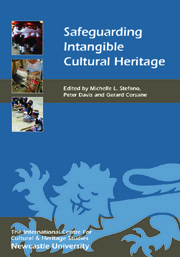Book contents
- Frontmatter
- Contents
- List of Illustrations
- Acknowledgments
- Touching the Intangible: An Introduction
- NEGOTIATING AND VALUING THE INTANGIBLE
- APPLYING THE INTANGIBLE CULTURAL HERITAGE CONCEPT
- ON THE GROUND: SAFEGUARDING THE INTANGIBLE
- 14 Acquiring the Tools for Safeguarding Intangible Heritage: Lessons from an ICH Field School in Lamphun, Thailand
- 15 Intangible Threads: Curating the Living Heritage of Dayak Ikat Weaving
- 16 Conversation Piece: Intangible Cultural Heritage in South Africa
- 17 Revitalising Amerindian Intangible Cultural Heritage in Guyana and its Value for Sustainable Tourism
- 18 When ICH Takes Hold of the Local Reality in Brazil: Notes from the Brazilian State of Pernambuco
- 19 Reconfiguring the Framework: Adopting an Ecomuseological Approach for Safeguarding Intangible Cultural Heritage
- 20 Conversation Piece: Intangible Cultural Heritage in Italy
- 21 Looking to the Future: The en-compass Project as a Way Forward for Safeguarding Intangible Cultural Heritage
- List of Contributors
- Index
15 - Intangible Threads: Curating the Living Heritage of Dayak Ikat Weaving
from ON THE GROUND: SAFEGUARDING THE INTANGIBLE
Published online by Cambridge University Press: 05 February 2013
- Frontmatter
- Contents
- List of Illustrations
- Acknowledgments
- Touching the Intangible: An Introduction
- NEGOTIATING AND VALUING THE INTANGIBLE
- APPLYING THE INTANGIBLE CULTURAL HERITAGE CONCEPT
- ON THE GROUND: SAFEGUARDING THE INTANGIBLE
- 14 Acquiring the Tools for Safeguarding Intangible Heritage: Lessons from an ICH Field School in Lamphun, Thailand
- 15 Intangible Threads: Curating the Living Heritage of Dayak Ikat Weaving
- 16 Conversation Piece: Intangible Cultural Heritage in South Africa
- 17 Revitalising Amerindian Intangible Cultural Heritage in Guyana and its Value for Sustainable Tourism
- 18 When ICH Takes Hold of the Local Reality in Brazil: Notes from the Brazilian State of Pernambuco
- 19 Reconfiguring the Framework: Adopting an Ecomuseological Approach for Safeguarding Intangible Cultural Heritage
- 20 Conversation Piece: Intangible Cultural Heritage in Italy
- 21 Looking to the Future: The en-compass Project as a Way Forward for Safeguarding Intangible Cultural Heritage
- List of Contributors
- Index
Summary
A few decades ago, the ikat weaving tradition of the Dayaks, the indigenous people of Kalimantan (Indonesian Borneo), was considered a disappearing art (Gittinger 1979; Heppell 1994), but through the work of the Dayak Ikat Weaving Project based in Sintang, West Kalimantan, the tradition has been revived.
This chapter considers the role the Weaving Project plays in the revitalisation and preservation of intangible cultural heritage (ICH) associated with Dayak weaving. The Project is examined in the light of preservation strategies recommended under the 2003 UNESCO Convention for the Safeguarding of the Intangible Cultural Heritage as well as Indonesian laws recently enacted or drafted to protect intellectual and cultural property. I suggest that efforts such as the Dayak Ikat Weaving Project offer more culturally appropriate, holistic and integrative heritage interventions than those proposed by the Convention and Indonesian laws. Special attention is given to indigenous curatorial practices embedded in Dayak ikat weaving traditions, and how these exist as both forms of intangible cultural heritage as well as strategies for their preservation. My goal is to show how the intangible cannot be detached from the tangible, or the whole fabric of life, and preservation strategies need to be informed by more ‘ecological thinking’, as Michael Brown recommends in his article ‘Heritage Trouble: Recent Work on the Protection of Intangible Cultural Property’ (2005). For Brown, ecological thinking is ‘characterized by holism and awareness of interconnections.’
- Type
- Chapter
- Information
- Safeguarding Intangible Cultural Heritage , pp. 177 - 194Publisher: Boydell & BrewerPrint publication year: 2012



